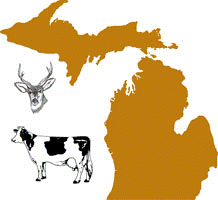Wildlife Disease and Zoonotics
Date of this Version
2003
Abstract
Mycobacterium infections occur in numerous wildlife species worldwide and this bacterial genus can also cause disease in humans and livestock. Two Mycobacterium species and one subspecies that infect wildlife are important from a wildlife damage management perspective. Mycobacterium avium, avian tuberculosis, is a ubiquitous and cosmopolitan disease of wild and domestic birds. Wild and domestic ruminants are host to M. avium paratuberculosis, also known as Johne’s disease. Finally, Mycobaterium bovis, bovine tuberculosis, is primarily associated with domestic and wild bovines and ungulates, but also infects many other species of mammals. Eradicating these diseases from wildlife populations is very difficult if not impossible. Preventing spill-over into domestic livestock herds is also problematic. We review the Mycobacterial diseases in wildlife and discuss their implications to livestock and human health. Our emphasis is on bovine tuberculosis and the current outbreak in northern Michigan, USA.



Comments
Published in Proceedings of the 10th Wildlife Damage Management Conference. (K.A. Fagerstone, G.W. Witmer, Eds). 2003